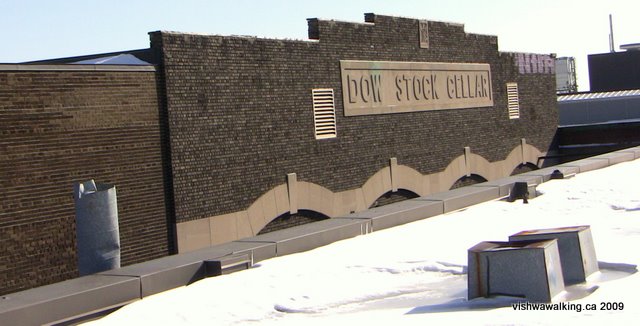About Us
Vishwawalking explained
 Ratings Explained
Ratings ExplainedVishwawalks
Day walks
Food
Funky Places
Future walks
Gear
Get Lost
Good reads
Links
Right to Ramble
Site map
Contact us
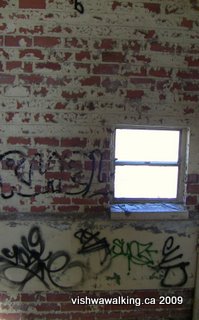
Vishwawalking
The Dow/O'Keefe Brewery, Montreal
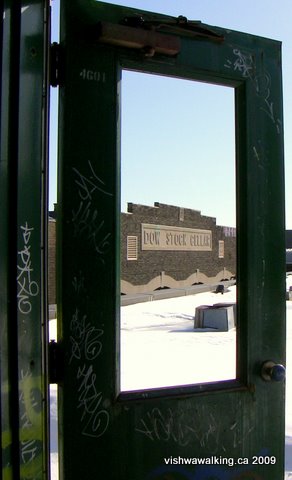 It
seems like operations in this building died a lot longer ago than they
actually did, in 1992. I explored this with my son, Matt and his
partner,
Rebecca.
It
seems like operations in this building died a lot longer ago than they
actually did, in 1992. I explored this with my son, Matt and his
partner,
Rebecca.Remember that this kind of exploration takes several visits. I have done only one, so regard this as an introduction.
Amongst urban explorers, the Dow Brewery is pretty popular, and with good reason. It's a fine adventure. [Standard warning: these adventures can be dangerous; this description in no way invites you to try it.]
History
In 1790, a Scotsman, Thomas Dunn set up brewing operations in Laprairie, outside of Montréal. In 1808, he moved it to Notre Dame Street in Montreal and in 1818 he took on an assistant, William Dow, who later became Dunn's partner.
The company became Dunn and Dow. in 1830, William was joined in the business by his brother Andrew. When Dunn died, they renamed the company W. Dow and Company.
In 1909, Dow amalgamated with another 13 companies to become National Breweries Limited. However, Dow still retained its identity. This was the beginning of a series of amalgamations as various beer giants attempted to control and monopolize the industry.
Up on the roof: looking toward the stock cellar
In 1952 E.P. Taylor's company, Canadian Breweries Limited, which already had O'Keefe under its wing, bought up National Breweries and renamed it Dow Breweries Limited.
Dow then spread across Canada, but retained its largest plant in Montréal.
In 1959, Dow was one of the major companies involved in charges of monopolizing the industry. At the time, it was almost impossible for small companies to get into the beer business.
In 1964, the company began construction of Dow Planetarium (now the Montréal Planetarium), near their downtown brewery. The completed project, costing $1.25 million was given to the city in 1966.
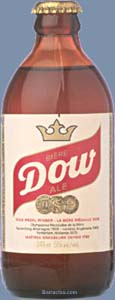
Unfortunately that year was also the year of the company's downfall. In 1966 it put an extra dose of cobalt into its brew to maintain its frothy head. Although nothing was conclusive, it was felt that the cobalt resulted in the deaths of between 16 and 25 people (figures differ in reports) and a number of sicknesses. All of those who died were heavy drinkers.
Dow, in an an attempt to keep its reputation, dumped tons of beer into the St. Lawrence River (!) as a goodwill gesture, even though they maintained they had untainted beer. However, when beer companies were ordered not to put cobalt into their beer, no new deaths occurred. Dow beer went from being the number one beer in Quebec in 1966 to almost nothing.
Canadian Breweries was sold to Rothman's Pall Mall in 1968-69 as part of an ongoing love affair between booze and the weed. In 1972, Molson purchased, produced and marketed the Dow brand.
The old "stubby"
from back in the day
Photo: external site
I can well remember the jaunty slogan's of Dow. "Wouldn't a Dow go good now" was it's most famous. "Dit donc Dow," was the French version of the English slogan, "Now for a Dow."
Some sources for the above: Macleans's magazine, Brewed in Canada, Brewing in Canada. Finding dates for the actual closure of the building is dodgy on the Internet. They range from the mid-1960s (which is dead wrong) to the mid-1990s (which is more likely). I picked the most reliable, and figured about 1992.
The building
The brick building was built in 1923 by Louis-Auguste Amos. The stone and wood sections go back to 1860.
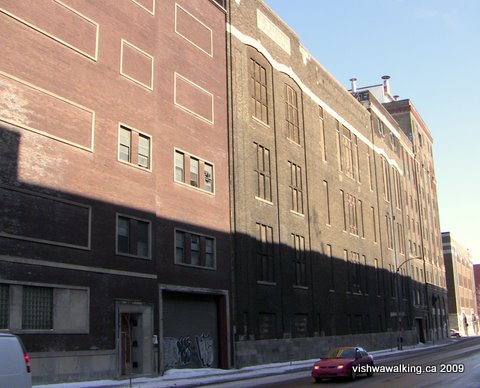 Required
equipment: A flashlight. Solid shoes (no running shoes that could be
punctured by sharp objects). Work-style clothes you won't mind getting
dirty.
Required
equipment: A flashlight. Solid shoes (no running shoes that could be
punctured by sharp objects). Work-style clothes you won't mind getting
dirty.There are two connected buildings. We investigated the northern one.
Getting in took a bit of wandering around. Some avenues have been made difficult. A fire escape at the back of the building lacks bottom rungs, making an obvious entry more difficult. In the end, finding the entry is part of the adventure (after all this is not a walk in the park). Look out for big garage doors; they may help.
The front of the building. We explored the left (red-brick) side.
Once into the inner sanctum, we walked over piles of frozen rubble in a loading dock until we found an open space into the basement to one side of the dock. It was pitch dark once inside and we had to look for exits that might show a glimmer of light.
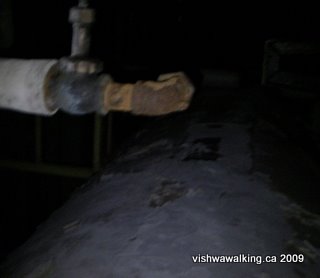
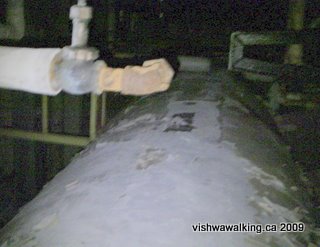
Bits of piping and machinery appear in the gloomy basement. On the left is what a flash photo captures, with natural exposure. On the right the fill light has been grossly overdone; strange parts appear.
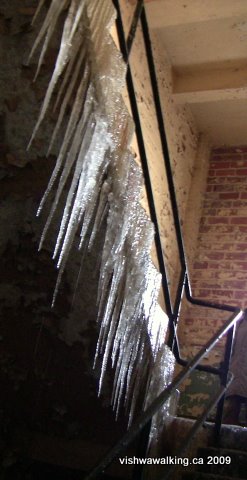 Walking
off to the edges we found that light and then a stairway with metal
railings. Water had dripped down on some steps and frozen. We had to
step carefully
Walking
off to the edges we found that light and then a stairway with metal
railings. Water had dripped down on some steps and frozen. We had to
step carefullyYou can take each floor level as they come or climb to the top of the building, you can take a stroll on the roof and investigate rooms as you descend.
I won't describe each floor in detail. The photos tell a better tale. There are no guidebooks here, so all you can do is marvel at the rusting beer tanks, bits of machinery and evidence of folks who may have made the brewery home for a while.
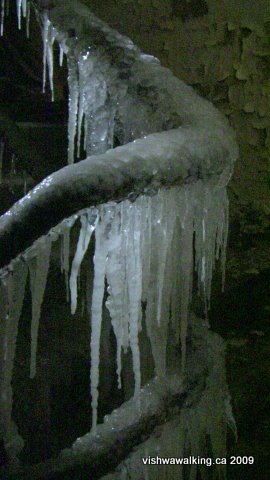 Watch the banisters. Some are
okay (left). Some could be disastrous (right).
Watch the banisters. Some are
okay (left). Some could be disastrous (right).The stairs need to be taken with care in winter. Water has dripped in from the roof and covers the first couple of floors of of the upper stairs. Overall, extreme care needs to be taken on floors as well for both ice (see below) and rubbish.
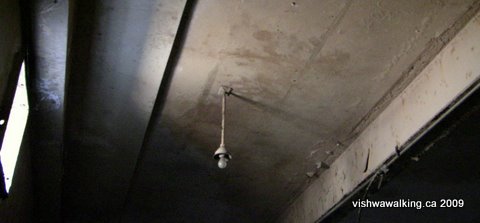
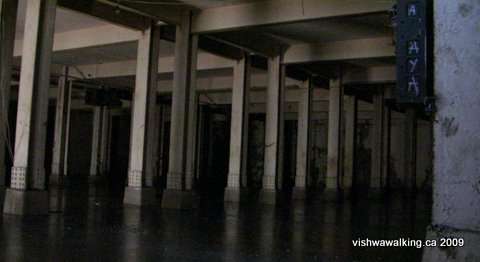
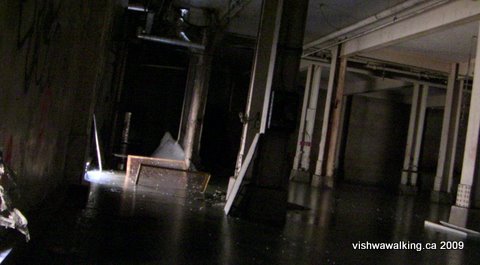
We didn't venture onto this icy floor. There was no way to tell how secure the floor was, so we admired it from a distance. in the same room, an opening high up (see the light bulb picture above) made interesting shapes below.
These are solid beams; to an amateur at least, this is a very solid building.
Below left: someone has constructed a fine throne out of a vehicle seat and some machinery.
Below, right: The graffiti in the building is not of a particularly high quality. For some images of better stuff see these fine photos. For a company that corporations might glom on to (unfortunately) see Goodbye Graffiti. One of these days, I must chronicle a graffiti walk; Montreal has some great ones.
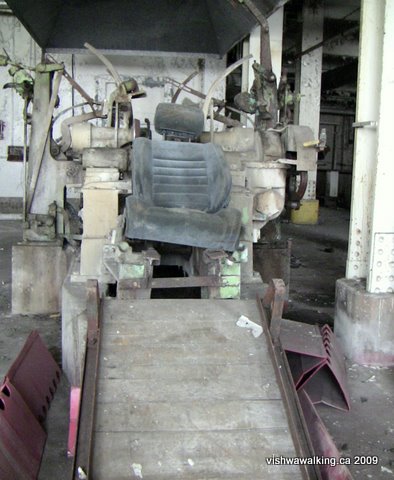
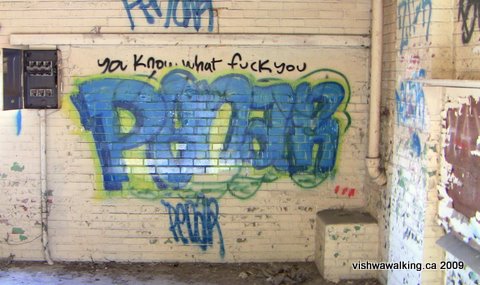
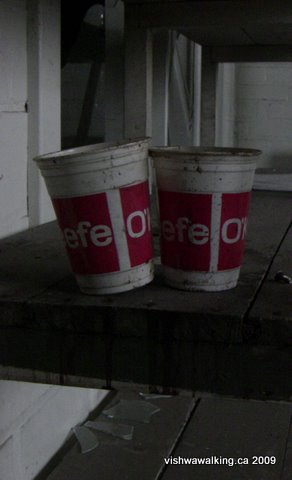
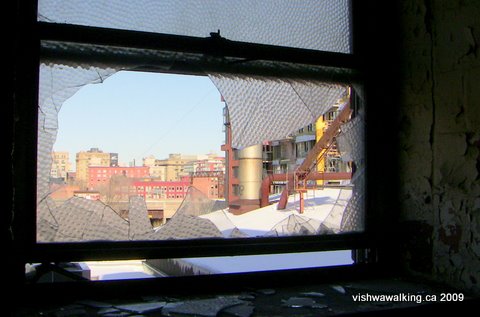
Above: The world outside framed by a broken window.
Right: These old plastic cups still hang about. I hope no one takes them home for a souvenir; they deserve to remain in the museum. (Take a picture, it;'s better.)
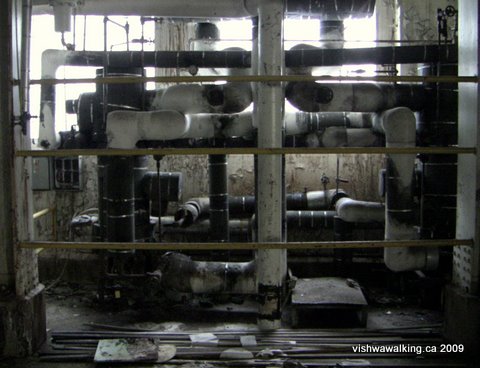
These pipes were in the top full floor. There's a turret-like floor above containing (perhaps) the elevator machinery.
This may have been the brewing room as there were big tanks in the same area.
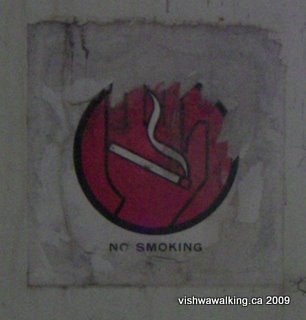
We end with a piece of social propaganda from Dow. Good advice. Too bad some beer industry giants were and are in bed with the smoking industry. This sign was posted on a pillar. The guy holding the lighted cigarette against his skin must have been pretty tough — or drunk. Pass the cobalt, buddy...
Have a look at this funky map of various unusual Montréal sites. The Dow Brewery is number two.
Chronicles of other adventurers: Urban Lookout, Urban Exploration Montreal (UEM), photos by Aleks Labuda (includes a number of buildings). Ooh, and it has ghosts!
Home | Contact Us | Site Map
Walked:
February 28, 2009
Page created: May 3, 2009
Updated: May 5, 2009
Page created: May 3, 2009
Updated: May 5, 2009
